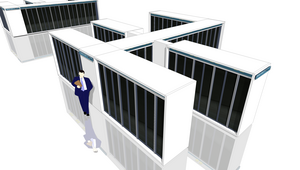| CDC STAR-100 | |
|---|---|
 Two CDC STAR-100, in 8 MB version (forefront) and 4 MB version (background) | |
| Design | |
| Manufacturer | Control Data Corporation |
| Designer | Jim Thornton |
| Release date | 1974[1] |
| Casing | |
| Dimensions | Full computer approx: Height: 212 cm (83 in) Length: 745 cm (293 in) Internal sections:[2] Height: 76 in (190 cm) Width: 28.5 in (72 cm) Depth: 30 in (76 cm) |
| Weight | 2,200 pounds (1,000 kg) |
| Power | 250 kW @ 208 V 400 Hz[2] |
| System | |
| Operating system | HELIOS [2] |
| CPU | 64-bit processor @ 25 MHz[1] |
| Memory | Up to 8 megabytes (4 * 4 * 64K x 64 bits) [3] |
| Storage | - |
| MIPS | 1 MIPS (Scalar)[4][2] |
| FLOPS | 100 MFLOPS (Vector)[1] |
| Predecessor | - |
| Successor | CDC Cyber 200 |
The CDC STAR-100 is a vector supercomputer that was designed, manufactured, and marketed by Control Data Corporation (CDC). It was one of the first machines to use a vector processor to improve performance on appropriate scientific applications. It was also the first supercomputer to use integrated circuits and the first to be equipped with one million words of computer memory.[5]
STAR is a blend of STrings (of binary digits) and ARrays.[6] The 100 alludes to the nominal peak processing speed of 100 million floating point operations per second (MFLOPS);[5] the earlier CDC 7600 provided peak performance of 36 MFLOPS but more typically ran at around 10 MFLOPS.
The design was part of a bid made to Lawrence Livermore National Laboratory (LLNL) in the mid-1960s.[5] Livermore was looking for a partner who would build a much faster machine on their own budget and then lease the resulting design to the lab. It was announced publicly in the early 1970s, and on 17 August 1971, CDC announced that General Motors had placed the first commercial order for it.
A number of basic design features of the machine meant that its real-world performance was much lower than expected when first used commercially in 1974, and was one of the primary reasons CDC was pushed from its former dominance in the supercomputer market when the Cray-1 was announced in 1975. Only three STAR-100 systems were delivered, two to LLNL and another to NASA Langley Research Center.
- ^ a b c LARGE COMPUTER SYSTEMS AND NEW ARCHITECTURES, T. Bloch, CERN, Geneva, Switzerland, November 1978
- ^ a b c d A Proposal to the Atlas Computer Laboratory for a STAR Computer System, Michael Baylis, Control Data, April 1972
- ^ Star-100 Hardware Reference Manual
- ^ Whetstone Benchmark History and Results
- ^ a b c Cite error: The named reference
Mackenzie1998was invoked but never defined (see the help page). - ^ C. J. Purcell (1974). "The Control Data STAR-100 - Performance measurements". AFIPS 1974 International Workshop on Managing Requirements Knowledge. p. 385. doi:10.1109/AFIPS.1974.113. S2CID 43509695.
